

Workshop: Introduction to
the Programming Language
Go
Marcel Schneider
Agenda for today
- Intro
- Go Basics & Soundex
- Coffee Break
- Object Orientation & Movie Database
- Concurrency & Website Checker
- Cool Down & Feedback
Goals of this Workshop
- Learn the Basics of Go
- Write, compile and run Go Apps
- Create a REST Webservice with Go
- Understand Error Handling, Testing, Object Orientation and Concurrency in Go
Tools you need locally
- Latest Go Version
- IDE (maybe VS Code or Goland/IntelliJ)
- Git
Helpful Links
Slides: bridgingit-gmbh.github.io/go-workshopGit Repo: github.com/bridgingit-gmbh/go-workshop
Tour of Go
Standard Library
Go Playground
Go History
| 2007 | Work on Go started at Google |
| 2012 | Release Version 1.0 |
| 2012 | first Go Conference in Denver/Colorado |
| 2022 | Introduction of Generics in Release 1.18 |
| 2025 | current Release is 1.25.1 |
Companies using Go
Motivation behind Go
Go Features
- Compilation into Machine Code
- static Typing (with Type Inference)
- Concurrency with lightweight Threads
- automatic Garbage Collection
- built-in Dependency Management
- completely OpenSource (BSD License)
- extensive standard Library (pkg.go.dev)
DEMO: Hello World
Language Characteristics
Exercise 1a: Soundex
- Phonetic Algorithm for Indexing Names by Sound, as pronounced in English
- Description of (engl.) Soundex Algorithm, see https://de.wikipedia.org/wiki/Soundex
- Examples: Golang → G452, Soundex → S532
Exercise 1a: Soundex Algorithm

- first Letter uppercase, followed by exactly 3 Numbers (Soundex → S532)
- Mapping of Letters see Table
- no Mapping for A/E/I/O/U/H/W/Y
- no consecutive equal Numbers
- ensure length 4, add Zeros or cut
- Hallo → H400, Entwicklertag → E532
Exercise 1a: Soundex Setup
- git clone -b workshop
github.com/bridgingit-gmbh/go-workshop - cd go-workshop/soundex-go
- go build
- ./soundex-go (.exe on Windows)
user@pc % ./soundex-go
implement me
Exercise 1a: Soundex Coding
- Implement the Function in soundex.go
package soundex func Soundex(input string) string { return "implement me" } - Test your implementation
user@pc % go test ok github.com/go-workshop/soundex-go/soundex 0.303s
Error Handling
- no try/catch, no Exceptions
- Error as additional Return Type
- Error == nil means no Error
type error interface {
Error() string
}
DEMO: Error Handling
Exercise 1b: Soundex Errors
- adjust Signature of Soundex Function
package soundex func Soundex(input string) (string, error) { //your code here return result, err } - return Error on empty Input String
- check return values in main() and print the error
- add a test for the error case
Exercise 1c: Soundex Testify
- add Dependency: go get github.com/stretchr/testify → see updated go.mod
- use testify Assertions in your Tests
- update all dependencies: go get -u
- cleanup dependencies: go mod tidy
Next Topic: Object Orientation
- supported, but without Classes
- Methods can be defined on Structs
- Composition over Inheritance
- implicit Interface Implementation
DEMO: Object Orientation
Exercise 2: Movie Database
- REST Webservice which manages Movie Data
- HTTP Request Mapping with Go Standard Library
- Usage of hardcoded Example Movies
Exercise 2: Implement REST Call
- navigate to Subfolder moviedb-go
- implement Endpoint GET /movies/{id}
- create InMemoryRepository (File inmemory.go) which fulfills the existing Interface MovieRepository
- see example-data.go for movie test data
- test the Implementation with your Browser
Next Topic: Concurrency
Demo: Channel
Exercise 3: Website Checker
- App which checks the Reachability of Websites
- currently the App executes the Checks sequentially
- Goal: Execute the Checks concurrently and use Channel Synchronization
Exercise 3: Website Checker
- navigate to Subfolder website-checker-go
- run the Checks concurrently
- transmit the Results to a Channel
- receive Results in main() and print them
- compare Running Time sequential vs. concurrent
Conclusion and Feedback
- Small Memory Footprint and fast Startup Time
- Lightweight Ecosystem
- Good online Documentation
- What did You like in Go (or not)?
